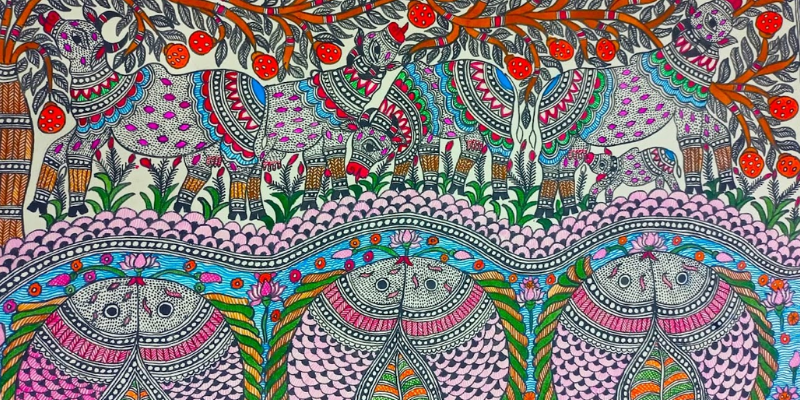What is Madhubani Painting?

Background and Origins of Madhubani Art
Key Milestones in Madhubani Art History
Tradition & Practice:
Style of Madhubani Painting
Madhubani painting encompasses several distinct styles, each with unique features and cultural significance. Bharni is known for its bold black outlines and vibrant colors like red, green, blue, and pink, often depicting mythological themes such as Hindu gods and epics. In contrast, Kachni focuses on fine line work, using monochrome or limited colors with intricate patterns created through hatching and dots, emphasizing precision and elegance. Godna style, rooted in Dalit tattoo traditions, features concentric patterns and tribal motifs, originally in black ink and later in earthy tones, celebrating identity and resistance through local deities like Raja Salhesh. Kohbar paintings are traditionally drawn on nuptial chamber walls and are rich with fertility symbols, representing blessings for marital harmony. Tantrik Madhubani art is deeply spiritual, portraying deities like Maha Kali, Durga, and Ganesh, along with sacred yantras and symbols from religious texts. While Bharni and Kachni were historically practiced by upper-caste women, Godna emerged from marginalized voices. Today, all styles are practiced across communities. Each form transforms cultural beliefs into vibrant visual narratives. Together, they reflect the diversity, devotion, and artistic mastery of the Mithila region.

Key Artists and Their Contributions
- Hema Devi (Catterfly Master Artist) - Hema Devi is a renowned Madhubani artist from the Mithila region of Bihar. She began learning the art form from her mother, Leela Devi, at the age of 15 and also learned papier-mâché from her mother-in-law, Subhadra Devi. Both her mother and mother-in-law are National Award winners. Hema Devi herself has received several awards, including a National Award for Madhubani painting and a Bihar state award for papier-mâché. She is known for her mastery of both traditional Madhubani styles and for using digital platforms to popularize the art. Her work often features intricate details and storytelling inspired by myths and contemporary events. She is also a dedicated teacher who conducts workshops and trained many young artists.
Their legacy lives on through the next generation of artists. If you wish to learn Madhubani painting online and explore authentic artworks, check out our Catterfly Madhubani Artist
How to learn Madhubani Paintings
How Catterfly curates and conduct Art workshops
We thoughtfully curate themes for our artwork, drawing inspiration from a variety of sources including mythological stories, nature, festivals, and cultural traditions. Our master artist, Hema Devi ji, plays an active role in the theme selection process, offering her invaluable insights and expertise. While we occasionally explore digital sources for reference, we use them solely for inspiration—ensuring that every final painting is an original creation, not a replication. This careful approach allows us to preserve the authenticity of the art while staying creatively connected to both tradition and contemporary relevance.
Learn Madhubani Painting with Catterfly
- Live Workshops – Engage in a truly immersive learning experience by interacting directly with master artists in real-time. These live sessions allow you to ask questions, receive immediate feedback, and gain valuable insights into traditional techniques and styles. You’ll be guided step by step through the painting process, with expert tips and demonstrations that bring the art to life. This interactive format not only deepens your understanding but also creates a personal connection with the artist, making each session both enriching and inspiring. Whether you're perfecting your strokes or exploring new motifs, you’ll have the rare opportunity to learn firsthand from seasoned experts in a supportive, collaborative environment.
Enjoy the flexibility of learning at your own pace through a thoughtfully designed program that includes structured lessons, recorded sessions, and step-by-step guidance. Whether you're a beginner or looking to refine your skills, each module is crafted to help you progress confidently and comfortably. With access to high-quality recordings, you can revisit lessons anytime, allowing for a deeper understanding and consistent practice. Our expert instructors provide personalized feedback and detailed instruction, ensuring a rich and supportive learning experience tailored to your individual journey in the art form.
- Madhubani Courses - Learn the art of creating traditional motifs—from beginner to advanced levels—at your own pace through a comprehensive and well-structured learning experience. Our program is thoughtfully designed with step-by-step lessons, high-quality recorded sessions, and detailed guidance to support your artistic journey at every stage. Whether you’re just starting out or looking to refine your skills, you’ll explore a wide range of motifs, from simple patterns to complex traditional designs. Each lesson builds progressively, allowing you to develop confidence and mastery over time. With the flexibility to learn whenever and wherever you choose, and the support of expert instruction, you’ll gain a deep understanding of motif work while staying connected to the rich heritage of the art form.




















